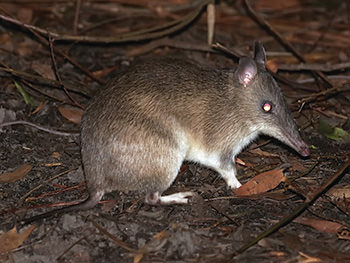
Northern Brown Bandicoots (banner image) are more commonly found in open forests, grasslands, canelands and gardens. Whereas Long-nosed Bandicoots (above) prefer wetter, more dense habitat, such as wet sclerophyll forests and rainforests.
Sometimes both species occur in the same location, especially in closed forest habitats that are adjacent to open forest habitats.
Most Land for Wildlifers in south-east Queensland (SEQ) will have had some sort of encounter with a bandicoot at one time or another. Whether it is waking to find a pock-marked lawn, a glimpse of a small brownish animal caught in the headlights as it gallops for safety or hearing a strange squeaking grunt in the dark. We have two local species in SEQ:
- the Northern Brown Bandicoot (Isoodon macrourus), which translates broadly as long-tailed equal-tooth, and
- the Long-nosed Bandicoot (Perameles nasuta), which means the notably-nosed pouched-badger.
I’d always assumed that the name ‘bandicoot’ was taken from one of Australia’s many Indigenous languages, but in fact, it was first used in India and is a corruption of the Telugu word ‘pandi-kokku’, which means pig-rat. However, they are not, as their name might suggest a rodent, but are marsupials and a close relative of the bilby. From the writings of Tom Petrie I have learnt that bandicoots are known as ‘yaggo’ in the Turrbal language and according to John Mathew as ‘dhun-kal’ by the Kabi Kabi (Gubbi Gubbi).
Bandicoots have been maligned, impugned and treated as vermin for much of the last 200 years. One of the reasons is that they were mistakenly thought to spread the Paralysis Tick (Ixodes holocyclus). There is little evidence to support this and they are just one of many mammals, birds and sometimes reptiles that play host to Paralysis Ticks.
“Yes, but what about the holes in my lawn!” someone shouts from the back. Recent studies of Quenda (or the Southern Brown Bandicoot) have shown that the digging by bandicoots, along with other native digging mammals, is a vital ecological service. This process, termed bioturbation, increases soil nutrient availability, microbial and fungal activity enough to significantly benefit seedlings that germinate in the spoil heap. This may not seem all that important, but when you consider that a single bandicoot might dig around 45 foraging pits each night it really starts to add up. In fact, it adds up to nearly 4 tonnes of soil cultivated per year. It also appears that the digging done by native animals with an omnivorous diet is more beneficial than the digging done by introduced herbivores such as the rabbit.
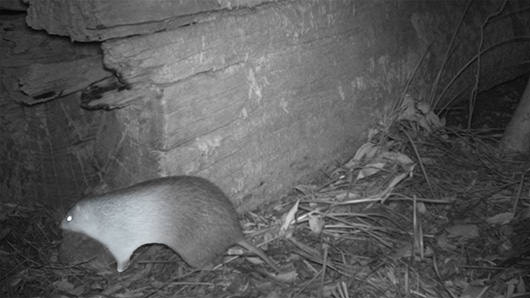
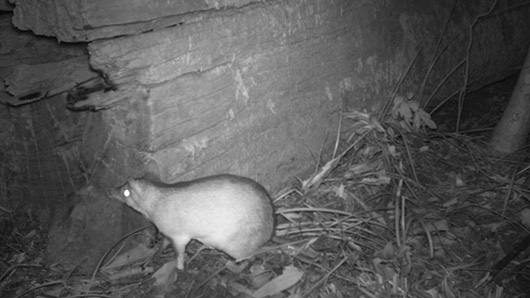
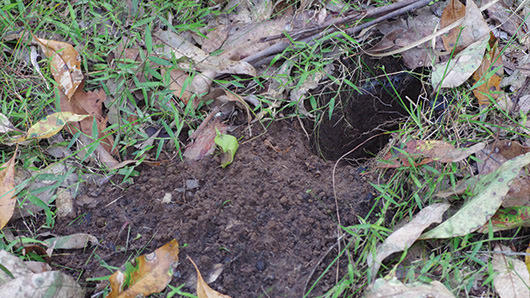
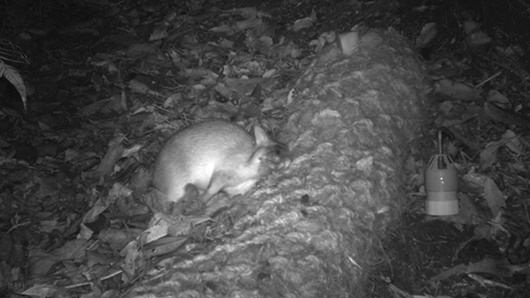
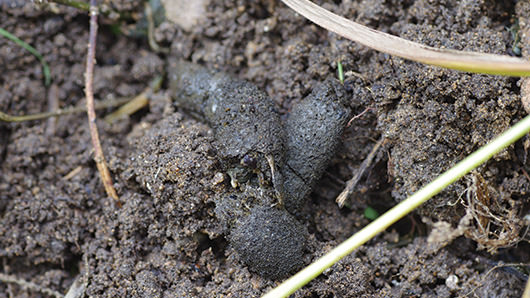
Despite falling smack bang in the middle of the ‘critical weight range’ of 200 grams to 5 kgs, in which our native mammals have been hardest hit by introduced predators such as cats and foxes, our local bandicoots have been remarkably persistent compared to the rest of the bandicoot and bilby clan (Family Peramelidae). Since European settlement, two species of bandicoot and one bilby have become extinct, another two are extinct or critically endangered on the mainland, and two more are classified as vulnerable to extinction. Only one, the Southern Brown Bandicoot, still shares the status of common with the Long-Nosed and Northern Brown Bandicoots, but it has experienced significant declines across its former range.
So, why do we still have bandicoots in SEQ when the rest of Australia is losing theirs? It’s certainly not due to their intelligence because bandicoots are dumb, really dumb. The ratio of actual brain mass compared to expected brain mass for a given body size is called the encephalisation quotient (EQ). The typical range for mammals is 0.5-1.5. Humans are an extreme case having an EQ of up to 7.0, while at the other end of the scale bandicoots are less than half as brainy as expected with an EQ of less than 0.5. The ability of our two local bandicoots to persist where other marsupials of a similar size have declined is pretty much all down to some fairly impressive reproductive traits.
The Long-nosed and Northern Brown Bandicoots have a gestation period of just 12.5 days (one of the shortest of all marsupials) and conditions for breeding in SEQ are favourable pretty much throughout the year. Females can start breeding at 4-5 months of age and produce up to 4 litters of 2-4 young per year.
The newborn young are about the size of a baked bean and, like other marsupials, are relatively undeveloped. While still attached to the placenta by an umbilical cord they crawl a short distance to a backwards facing pouch where they attach to one of eight teats. They grow rapidly and are ready to leave the pouch at about 50-55 days with weaning occurring at about 60 days. Females can mate again while they have pouch young and give birth to a new litter soon after the previous young have been weaned.
Typically, bandicoots are solitary creatures that only come together for mating. Even young bandicoots are on their own just a few days after being weaned if the mother has given birth to another litter. During the day, they shelter in a camouflaged nest of grass and leaves that sometimes will have soil raked over the top to improve its weatherproofing.
Whether it is because they are common and look a little like a large rat or the bad press that they have received since European settlement, bandicoots are often overlooked or dismissed by us humans. They deserve better than this. They are essential for the ecological well-being of our forests and despite threats from introduced predators, pets, habitat loss and roads they manage to hang in there. So while they have been lost from urban areas or intense agricultural lands they are still reasonably common where there is suitable habitat.
To help bandicoots return to, or continue to find a home on, your Land for Wildlife property you can help by:
- Retaining or restoring areas of native grass and shrubs.
- Restricting livestock access to areas of bushland.
- Retaining leaf litter and dead timber on the ground.
- Avoid frequent burning.
- Being a responsible pet owner.
- If you have a pool, make a wildlife ramp out of a piece of wood or heavy rope.
Article by
Alan Wynn
Conservation Partnerships Officer
Sunshine Coast Council
References & Further Reading
Lydecker HW, Stanfield E, Lo N, Hochuli DF and Banks PB (2015) Are urban bandicoots solely to blame for tick concerns? Australian Zoologist, 37(3) 288-293.
Milewski A (2018) Of Bandicoots, Beaks and Braininess. Wildlife Australia, 55(2) 31-34.
Queensland Museum (2007) Wildlife of Greater Brisbane. 2nd Edition. Queensland Museum.
Valentine L, Ruthrof K & Hobbs R (2018) Scratching Below the Surface with Marsupial Diggers. Decision Point Online, October.
Van Dyck S & Strahan R (eds) (2008) The Mammals of Australia. 3rd Edition. New Holland.
https://environment.des.qld.gov.au/wildlife/livingwith/bandicoots.html

Hi, I believe I came across a northern brown bandicoot this evening. I was collecting water from a very quiet out of the way water station. Very bushy area. What I first thought was a huge rat ran across the road, just in front of me. It even stopped so I was saying hello to him, than he ran into the Bush again. I went home to research right away what it could have been. I was very taken back by how how can I say, dumb he was. But I would bet my last dollar it was a bandicoot. Not a long nose. The northern brown bandicoot. I thought I’d mention in case your recording aintings. My email address is attached if you want exact location please contact me. Thanking you
Hi , about two months ago I noticed the diggings of a long nosed bandicoot by my ponds in my garden and then the next day saw him being chased up a tree by the local crows. They were quite persistent and would have given him a great fright but I do not believe they harmed him as he was hiding in the thickest part of an old mango tree. I live in Ipswich but have extensively changed my garden to be friendly for the local native wildlife and have two creek systems with ponds. One is specifically for frogs while the largest is for native fish.
I believe i almost hit a bandicoot on the road in the middle of the night about 30 minutes out from Kingaroy. Cant give a positive ID , it hopped similar to a kangaroo but was the size of a rabbit with a pointed snout
Hi, We have what looks like a Short Nosed Bandicoot in our garden. We see him/her quite regularly. I’d love to know exactly what it is? He/she moves like a kangaroo, rather than running like a rat. Actually he kind of looks like a Quenda 😉 I’d love your advice… I even have a video I can send for assistance in identifying. It’s such a dear creature! Thanks so much.
We have just moved to near the jimboomba township, i read bandicoots are solitary animals. Well if thats the case we must have at least 30 of them on our 1 acre lot. All seem to be long nosed brown ones. Have never seen the same one twice, each time its a different one
Send me the video and I will work it out
Keep safe
Hi there, I believe we just found a bandicoot in Burleigh Heads, unfortunately dead on the side of the road. I have a photo if you need to confirm this for your statistics.
Hi Chelsey. We encourage people to log wildlife sightings via iNaturalist – it’s free and easy to join https://www.inaturalist.org/login
I live in the suburb of Mitchelton in Brisbane.
Last night I went outside to turn off our Christmas lights and while doing so something comes scurrying along the driveway and nearly runs into me before seeing me and abruptly stopping. I look at it. It looks at me. It was about the size of a possum, so that was my 1st thought, then I had a closer look and said to myself, that’s not a possum, is it a giant rat? No, not a rat. I stepped aside and it scooted around me and hopped across the road using its big hind feet, like a kangaroo would hop. That’s a bandicoot, I exclaimed!!
I then went inside and looked up this site to confirm my spot. The one I saw is the Long-nosed Bandicoot, the one in the smaller photo above (underneath the banner photo), I haven’t seen a bandicoot in the (suburban) wild since I was a kid.
I was pretty excited and then I look up at our fence and saw our resident Golden Brushtail Possum (herself very rare) watching me looking bemused & wondering what all the fuss is about! She has been visiting our courtyard for years and we’ve seen her raise many baby possums over the years.
Hi..I came across a bandicoot crossing the road near my house in Sippy Downs, Sunshine Coast. About midnight..was not scared of the car..I had to stop otherwise I would have hit it. It was, I guess, returning to the bushland adjacent to houses. First time in over 10 years living in this area that I have seen a bandicoot.
A lady in Mount Cotton posted a photo of what looked like 2 Bandicoots that had drowned in her backyard pool. Very sad. The sight was “Redland Bay Area – Residents & Community” on 9/2/2022. Look like Northern Brown.
I have a mouse and rat issue here in Kooralbyn so Ive been bating the critters for a while now. What has really concerned me over the past 3 months is that the bait stations have been moved and all the bait keeps disappearing. I figured it must be one hell of a rat to up turn these bait stations. Ive set a animal friendly trap/cage to catch the culprit. Tonight I caught it and it ended up being a long nose bandicoot. It seems to be thriving in my yard so I wont change the layout as I have lots of native grasses and shrubs. Ive also put in 2 ponds over the years to give the wildlife a place to have a drink. Call my property a safe haven for wildlife. What I would like to make people aware of is that bandicoots seem to love bait stations so please be mindful of this and think carefully how and where you place these stations. Im glad I caught this bandicoot as I will now reassess how I bait the rats and mice. I will endeavor to continue to make my property as safe as possible for our small wildlife friends. Please help our small friends by giving them a place to live and thrive. We have destroyed too much of their environments. Im not part of green peace or a greenie but I do believe that all gods creatures have a right to live on and in piece on this planet.
We have what I think is more than 2 Northern Brown Bandicoots running around at night. Every night I catch site of 1 or 2 of them. First I thought it maybe echidna’s which we also have and they leave a mess when digging around always. But after I started seeing all the hole around the yard, we joking said ” well we don’t have to air rate the lawn. They just set and watch before taking off. My dog spotting one one night before I did and she was off and so was it. She did catch it thankfully. They’ve made a mess of the yard, the chook house and around all my fruit trees. We’ve been in this area for nearly 10yrs and never have one or the problem they’ve done to our lawn. Lovely to know they are around and nice to catch site of them. I was blown away how big they area. We live in a rural farming area. I love seeing new animals.
sorry, My dog didn’t catch the bandicoot, to fast
Hi we have I believe to be the Northern Brown Bandicoots on my parents property at Morayfield in QLD. My brother has photos and video from a night trail camera. Unfortunately the whole area has been purchased for development and destruction of a lot of the natural environment has already begun. Shame these beautiful animals will soon be destroyed and their habitat.
Hi, we have at least 3 of the Long-nosed Bandicoot (Perameles nasuta) in our yard. They are doing a great job of aerating the soil.
Esk, QLD
How likely is it that a small bandicoot about 7 inches long would come inside by squeezing under a roller door? about 1″ gap. Cat left it dead beside the bed and cat is certainly only an indoor cat. I’ve seen much larger ones like this outside, dead. and had huge bandicoot years ago. Heaps of holes in ground atm and there is forest and pond. Don’t have photo sorry. I’d hate to kill a bandicoot but there has been a mouse plague here and neighbours are killing rats and mice with bait. Would the eco friendly? bait called ROBAN kill bandicoots. Heaps of wallabies and other wildlife here, ever so fortunate. Thanks for your info. Atkinson Dam area.
Hi, we were going down to our local apartment spa to have a touch of intimacy when all of a sudden we came across what is believed to be a bandicoot rummaging through the plants on the side of the path. Intimacy was quickly forgotten as the bandicoot came out to say hello and the attention was quickly drawn to how cute this little bugger was. This sighting occurred in Robina
Hello,
I live on Tamborine Mountain Queensland and am wondering why there seems to be a plague of bandicoots this year.
They are digging their holes in every garden and acreage But love mine the most. I don’t need to dig they do it for me, and as lovely as they are, I really don’t want them in my garden, dirt everywhere over paths and pavers. How they get their noses into the narrow spaces between the pavers, I don’t know and am not prepared to sit up at night waiting for them.
My question…why this year and why so many?
Thank you for reading my email….if in fact you do. 🙂
Laurie
Wow we’re in Harrisville and reading the comments above it seems like in our “region” there seems to be a lot in the last year. We just found one that has been dead for a while that our puppies dragged up to the top yard this was a couple weeks ago but then the farmer who lives around us set a trap while he was away because he didn’t know what was digging holes etc on there farm and caught 2 bandicoots. We had phascogale visit a year ago that attacked our chickens so I’m hoping bandicoots won’t harm them….. why are there so many sightings atm?
Hi Laurie, I live in Currumbin waters on the edge of Currumbin valley and we have heaps of bandicoot here this year as well. I would love to know the answer to your question (why so many this year), and would like to know if there are any habitats we can construct in our yards to encourage them to stick around?
Thanks for article and other input. 2023 winter we believe we had at least 8 bandicoots starting in July. This year waiting patiently but the colder weather kept them quiet until the last week (Ekka) and slowly one after another has come out as soon as dark not minding the full moon. They chatter away and speed around the block so fast for hours but are asleep by dawn. A very koala- type scent is noticeable in dark/dense bushes. The holes dug last year were prolific, this year 2024 early not yet seen digging so far but looking forward to many cheerful nights. Bandicoots are such chatterboxes and a pleasure to listen to. I find very comforting. Neighbours please keep your cats indoors..